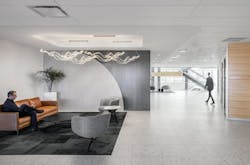A twist on office conversions maximizes leasable space
By John Caulfield, Senior Editor
There has been a lot of post-pandemic interest among developers about converting vacant office spaces to something more leasable, like residential apartments. That interest, though, has yet to turn into a groundswell of adaptive reuse, mainly because office-to-residential conversions can be complicated and expensive due to incompatible floorplates, ceiling heights, and code restrictions, to name but a few of the impediments AEC firms often cite.
As something of a compromise solution, one firm, NELSON Worldwide, has been touting a project it completed in March 2022 in Minnetonka, Minn., that converted a four-story building, which had been leased by a single tenant, into a Class A multi-tenant office space known as Crest Ridge, with a three-level attached parking ramp and heated garage.
The appeal of this 116,000-sf building, which was first constructed in 2008, is its location on the urban fringe, a wooded seven-acre campus with a lake, walking trails, and scenic views, says David Filak, NELSON’s Associate Principal and Regional Practice Leader-Asset Strategy.
The goal of the client, Larson Capital Management, for this conversion was to maximize the building’s leasability, and to add amenities that would attract different tenants. The conversion, however, presented challenges: the client wanted a big cafeteria in the building’s basement to be upgraded to leasable space. There was also a staircase that connects the floors of the building that needed to be brought up to safety and fire codes, partly by adding vestibules at the landing of each floor.
New amenities included a self-service food and beverage area at the base of the staircase; a fireplace, pool table, and perching stations near full-height windows; and a 70-person training and conference room adjoining a pre-function space. The building’s fully equipped fitness center was relocated to the first floor and upgraded. There’s new flooring on the second floor, and new furniture in the common areas that include a shared entertainment space.
The campus, which connects to Interstate 394, is within a half-mile of numerous restaurants and retail stores.
Listening to clients’ needs
Working with a local general contractor Gardner Builders, NELSON designed the building plan for multi-tenancy on behalf of the landlord and leasing team’s goals. Upon completion of the conversion, Old Republic Title leased 2½ floors. The building currently has four tenants, including Walker Methodist, One10, and Functional Neurology. Functional Neurology and Walker Methodist worked with NELSON on their fitouts. Filak says that the project’s budget, which initially had been $2.6 million, was trimmed by $1 million by scaling back on some amenities.
Since completing this project, NELSON has been getting inquiries from other developers interested in this kind of conversion. “A lot of developers and tenants are going through investigative processes,” says Filak. He adds that by listening to Larson Capital’s goals, “we were able to help them at every step of the way,” including with its leasing strategy in relation to the building’s interior design.
NELSON Worldwide contends that architects can identify strengths and weaknesses of a building by conducting a comprehensive analysis for repositioning, abetted by innovative technology like artificial intelligence. Transforming the building to meet current and changing market demands can improve its rental potential and expand the building’s lifespan.

